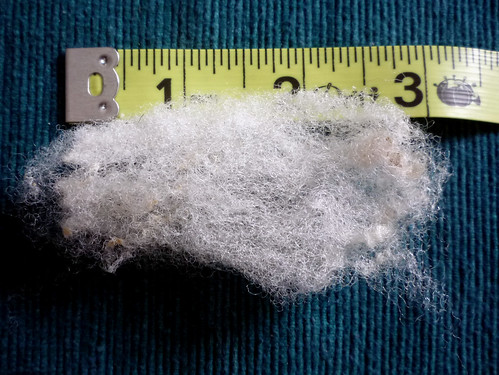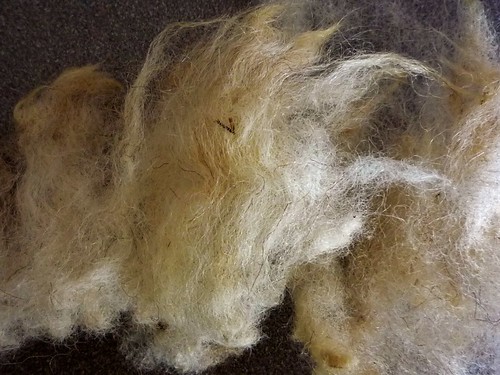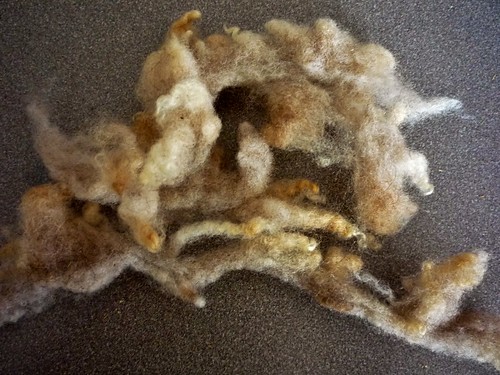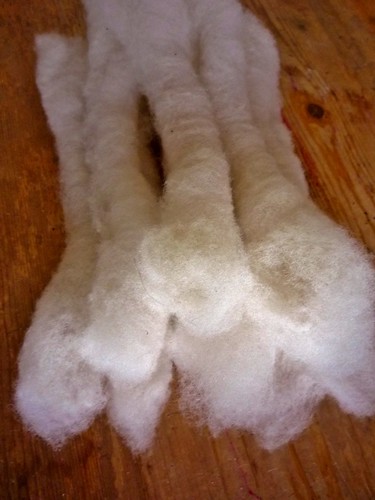I also picked up a tan alpaca fleece with both the blanket and second cut. I decided to card and spin the alpaca with the CR fleece, thinking it would only make the yarn softer. However, I had to use the second cut of alpaca, since the blanket cut was too long to card with the CR. This meant that it didn't really make the finished yarn softer. I was happy with it, but I only did about 5 or 6 oz altogether. This was that yarn:
It was a nice 2-ply, if a little coarser than I had hoped. I didn't have serious problems with it, besides it being a little neppy and shedding a million little bits.
My problems started when I decided to spin the California Red all by itself. Since the alpaca wasn't making it softer, and it was tan, not white, why bother with it? Besides, I wanted to see how this fleece would behave in a pure yarn. So I washed more of the fleece, and started carding with my hand cards.

I began to realize what was lurking under the grease and dirt.
This is a picture of a typical, nice lock:

Lots of crimp, springy, soft, white. But I found there are also a lot of locks like this:

Longer, wavy and not crimpy, lots of kemp, quite coarse, and darker. I think these sections are a throwback to the Blackbelly ancestry. Besides these long sections, there are some of these:

I would just chalk these up to short cuts, but the odd thing about them is that they are clearly a different color and crimp pattern again.
Those parts aren't annoying in themselves. I just have to relax and let myself toss them out. The worst part was discovering that a lot of the fleece- ok, most of it- has sun damaged tips which break and scatter and create neps while carding. Also, there seems to be a lot of, well, gunk, that won't wash out and is hard to get out any way at all. Some of it is sticky and is probably suint, some of it is dry and looks like dandruff, and a lot of it is vegetable matter. And there is a LOT of it, especially the dry stuff. So much that it is messy to card, hard to draft, and frustrating to spin.
I thought if I drum carded it, that might help, so I made a batt or two- carefully trimming off the damaged tips (with the help of a friend! Thank heavens for that!) and cleaning out the VM as much as possible. There were fewer neps, but it was still frustrating. I tried spinning it from the lock, opening and flicking them a little, which helped reduce the creation of the neps, but it was not fun. Spinning should be fun, right? And I was ready to wind off the bobbin of singles I'd managed to make and pretend that this experiment never happened. Except I'm so damned stubborn.
I picked up my hand cards again, wondering why I was having such a crappy time of it when it wasn't that bad last fall, and decided I would fill my second bobbin, ply it, and wash my hands of the whole affair. I carded another rolag or two and began to spin, when suddenly the wool started drafting like butter! I watched slubs dissolve in the drafting zone and neps popped off on their own. Whaaaa?? And then I remembered that I had been carding some of my new white alpaca fleece and hadn't cleaned out my carders.
Alpaca. I was carding with alpaca. The tan alpaca may have not made the fleece softer, but it made it smoother. Much smoother. I couldn't believe the little bit of alpaca on my cards had made such a huge difference, but it had. Like adding a little dab of butter to the pan of eggs, it does an almost invisible but effective job. So now I am adding a little white alpaca to the blend, and I am much happier with this project. This alpaca blanket is short enough that I don't have to cut it or anything to blend it in.

I'm glad I figured out this fleece. I am learning to let go of wanting control of the fleece, and to use every last little bit, and to stop trying to be a perfect spinner. It's ok that one ply of the yarn won't have alpaca and the others will. (I keep telling myself that). Yesterday I decided to ply up a hank of yarn, wash it and see whether it is worth proceeding with more singles, because I have given myself permission to ditch the fleece and the singles if it isn't.

I love this yarn. It's a 3 ply, and super smooshy, poofy, springy, and soft: the soft I had envisioned having when I picked out this fleece. I'm once again excited about making myself a sweater from this fleece. No, it's still not perfect and there still are neps that I have to pull out, but I am happy enough that I can keep going... and just keep my vacuum handy.

3 comments:
smooshy, poofy, springy and soft... sounds like a heavenly thing
Wow sounds like a lot of work. When I was in college the lady from the Alberta Sheep Association (or whatever they call it) said lots of people dont like wool from here cause we bed our sheep in straw rather than having them on grass so the wool is always a lot dirtier. I guess it would be nice if the wool started out with less goop in it.
Hm, interesting. I didn`t see much straw in it. If I had to guess I would say this sheep bedded down in bare dirt.
Post a Comment